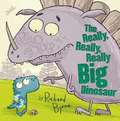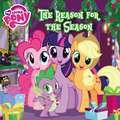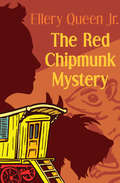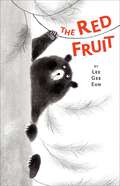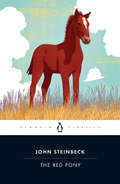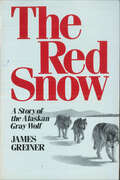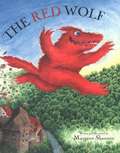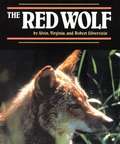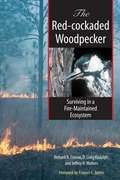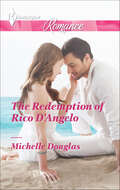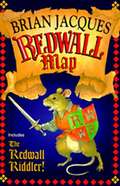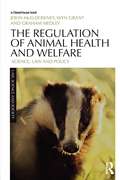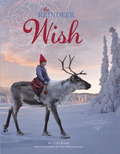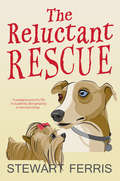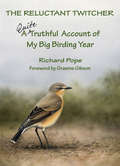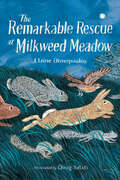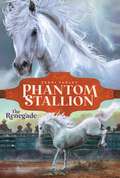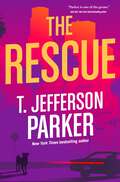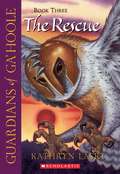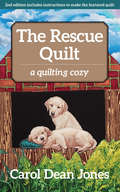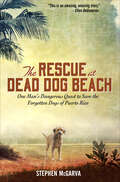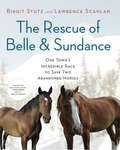- Table View
- List View
The Really Groovy Story of the Tortoise and the Hare
by Kristyn Crow Christina ForshayDeep inside the city was a hip and happy hare.He was zippy, sometimes lippy, takin' taxis everywhere. Way out in the country was a tortoise calm and cool.He was quite the mellow fellow chillin' out beside the pool.Kids will love to move and groove with this dynamic duo as they hop and pop toward the finish line in this hip-hopping retelling of the classic tale.
The Really, Really, Really Big Dinosaur
by Richard ByrneWhen a big show-off dinosaur learns to share, he discovers two really, really, really good new friends. And you'll never guess where he finds one of them! After children spot the cleverly hidden character in the illustrations, they'll want to go back and read the story again and again.
The Reason for the Season (My Little Pony)
by Louise AlexanderA holiday themed My Little Pony storybook!Includes Read-Aloud/Read-to-Me functionality, where available.© 2015 Hasbro. All Rights Reserved.
The Red Chipmunk Mystery (The Ellery Queen Jr. Mystery Stories #4)
by Ellery Queen Jr. Jr.Lost in a strange town, Djuna stumbles on an adventure On his way home after a summer of fun with his friends, Djuna and his dog, Champ, take advantage of a pit stop in Thompsonville to get off the train and stretch their legs. They have just left the station when Champ slips his leash and runs off into the crowd. Djuna charges after him, but by the time he finds his little dog, the train has left without them. When he reaches for his wallet to buy a new ticket, his pocket is empty. Someone has stolen his money! Stranded, Djuna and Champ will have to think on their feet if they are to find their way home. It's less than one hundred miles to Edenboro, but getting there will mean the adventure of a lifetime. Ellery Queen is one of the world's finest detectives, but his adventures are nothing compared to the Ellery Queen Jr. Mystery Stories. Join Queen's apprentice, Djuna, and his trusty Scottie, Champ, on adventures filled with danger, suspense, and thrills.
The Red Fruit
by Lee Gee EunBaby Bear is off exploring on his own. Tok! Now what’s this that just hit his head? Mmmm…it’s a delicious red fruit. He must get more. Up, up, up, to the top of the forest. Hello Caterpillar! Hello Squirrel! Hello Bees! Now what is that? Why, it’s the biggest red fruit of all! Baby Bear must have it. He leeeaaaps… From award-winning Korean illustrator Lee Gee Eun comes a gorgeously illustrated story – delightful at every beat – about first discoveries and always landing in a safe place.
The Red Hourglass: Lives of the Predators
by Gordon GriceSnake venom that digests human flesh. A building cleared of every living thing by a band of tiny spiders. An infant insect eating its living prey from within, saving the vital organs for last. These are among the deadly feats of natural engineering you'll witness inThe Red Hourglass,prize-winning author Gordon Grice's masterful, poetic, often dryly funny exploration of predators he has encountered around his rural Oklahoma home. Grice is a witty and intrepid guide through a world where mating ends in cannibalism, where killers possess toxins so lethal as to defy our ideas of a benevolent God, where spider remains, scattered like "the cast-off coats of untidy children," tell a quiet story of violent self-extermination. It's a world you'll recognize despite its exotic strangeness--the world in which we live. Unabashedly stepping into the mix, Grice abandons his role as objective observer with beguiling dark humor--collecting spiders and other vermin, decorating a tarantula's terrarium with dollhouse furniture, or forcing a battle between captive insects because he deems one "too stupid to live. " Kill. Eat. Mate. Die. Charting the simple brutality of the lives of these predators, Grice's starkly graceful essays guide us toward startling truths about our own predatory nature. The Red Hourglassbrings us face to fanged face with the inadequacy of our distinctions between normal and abnormal, dead and alive, innocent and evil. From the Hardcover edition.
The Red Pony (Penguin Modern Classics Ser.)
by John SteinbeckTells a story of a young boy and his life on his father's California ranch, raising a sorrel colt.
The Red Snow: A Story of the Alaskan Gray Wolf
by James GreinerIn The Red Snow, his second work, Greiner turns his keen eye to Alaska's vast wilderness and its most mysterious creature: the gray wolf. Basing his story on careful research and personal observation, Greiner recounts the lives of the Tanana River Valley wolf pack and the tough, lonely hunter, Jake, who inhabits their valley. In splendid detail, he describes the birth of pups, the victory of the hunt, and the habits of animals who share the wolves' valley. Yet in describing the beauty, he never forgets the harshness of the Arctic wilderness; Greiner makes the ugly realities of the fight for survival intensely clear.
The Red Wolf
by Margaret ShannonRoselupin has had quite enough of being locked away in her tower room. Her father the king thinks he needs to protect her from the wild and dangerous world outside, but Roselupin knows better. So when she receives a mysterious gift on her seventh birthday, Roselupin uses it as her ticket out of the tower and into the woods, where she howls and dances all day long-and surprises the kingdom folk right out of their socks. Twice.
The Red Wolf (Endangered in America)
by Alvin Silverstein Virginia Silverstein Robert SilversteinBy the mid-twentieth century red wolves had been driven almost to extinction by the human population. This book describes these animals and the recovery program that has begun to bring them back.
The Red-cockaded Woodpecker: Surviving in a Fire-Maintained Ecosystem
by D. Craig Rudolph Richard ConnerThough small among its woodpecker relatives, the Red-cockaded Woodpecker poses a huge dilemma for its human neighbors. <P><P>Uniquely adapted to live in the old-growth pine forests of the southeastern United States, the Red-cockaded Woodpecker has nearly disappeared as the forests have been cleared for agricultural, commercial, and residential uses over the last two centuries. Today, it waits at a crossroads. Scientific management practices could restore the woodpecker's habitat and population, but the imperative to convert old-growth forests to other uses remains. <P> In this book, three of the leading experts on the Red-cockaded Woodpecker offer a comprehensive overview of all that is currently known about its biology and natural history and about the ecology of the fire-maintained forests it requires for survival. As the most visible endangered species in the Southeast, and the one whose conservation impacts the largest land area, the Red-cockaded Woodpecker holds a compelling interest not only for ornithologists, but also for wildlife managers, foresters, developers, environmentalists, and government officials. For all of these groups, this book will be the essential resource for learning more about the Red-cockaded Woodpecker and ensuring its survival.
The Redemption of Rico D'Angelo
by Michelle DouglasThe man behind the Italian good looks... Gorgeous Rico D'Angelo is single-handedly saving the world, one disadvantaged teen at a time. The opening of his charity café should be enough for him to finally put the regrets of his childhood behind him...but even as the ribbon is cut on opening day it's not enough. Until new hire Neen Cuthbert walks through the door and offers an unexpected blast of sunshine! She's had her fill of misguided do-gooders, but something tells her Rico is different. Neen won't let him push her away-especially now she's discovering that Rico might just need her most of all....
The Redwall Riddler
by Brian JacquesTest your Redwall knowledge with "The Redwall Riddler"--full of riddles, quick-fire suggestions, and baffling word puzzles.
The Regulation of Animal Health and Welfare: Science, Law and Policy (Law, Science and Society)
by Wyn Grant John McEldowney Graham MedleyThe Regulation of Animal Health and Welfare draws on the research of scientists, lawyers, economists and political scientists to address the current and future regulatory problems posed by the issues of animal health and disease. Recent events such as the outbreak of mad cow disease, epidemics of foot and mouth disease, concerns about bluetongue in sheep, and the entry into the food chain of the offspring of cloned cattle, have heightened awareness of the issues of regulation in animal disease and welfare. This book critically appraises the existing regulatory institutions and guiding principles of how best to maintain animal health in the context of social change and a developing global economy. Addressing considerations of sound science, the role of risk management, and the allocation of responsibilities, it also takes up the theoretical and practical challenges which here – and elsewhere – attend the co-operation of scientists, social scientists, lawyers and policy makers. Indeed, the collaboration of scientists and social scientists in determined and regulatory contexts such as that of animal disease is an issue of ever-increasing importance. This book will be of considerable value to those with interests in this issue, as well as those concerned with the law and policy relating to animal health and welfare.
The Reindeer Wish (A Wish Book)
by Per Breiehagen Lori EvertNew York Times bestselling duo Lori Evert and Per Breiehagen (The Christmas Wish and The Tiny Wish) sweep us back into their enchanting world with yet another breathtaking adventure featuring their daughter, Anja. When Anja discovers an abandoned reindeer baby in the woods, she cares for it and raises it as her own. They become dear friends and have many adventures together, but as the reindeer grows he wishes to rejoin his kind. So Anja leads him to join the greatest reindeer of all--those of Santa's sled team.
The Reluctant Rescue
by Stewart FerrisMeet Pooch, the top dog living a life of luxury. Until, that is, his humans adopt a Greek stray called Mary and bring her back to England.For Mary living in a home with lawns, sofas and unlimited food is heaven. Pooch, however, struggles to share his paradise.When another stray called Brando arrives on the scene, things only get worse. Will Pooch ever learn to love his newfound companions?Heart-warming and hilarious, this is the true story of the rescue of stray dogs from Greece.
The Reluctant Rescue
by Stewart FerrisMeet Pooch, the top dog living a life of luxury. Until, that is, his humans adopt a Greek stray called Mary and bring her back to England.For Mary living in a home with lawns, sofas and unlimited food is heaven. Pooch, however, struggles to share his paradise.When another stray called Brando arrives on the scene, things only get worse. Will Pooch ever learn to love his newfound companions?Heart-warming and hilarious, this is the true story of the rescue of stray dogs from Greece.
The Reluctant Twitcher: A Quite Truthful Account of My Big Birding Year
by Richard PopeRichard Pope, author of Me n Len: Life in the Haliburton Bush, 1900-1940 and the voyageur epic Superior Illusions, is a recently retired professor of Russian literature and culture at York University and a long-standing member of the Ontario Ornithological Club and the Ontario Field Ornithologists. He and his wife, Felicity, live in Cobourg, Ontario. The human side of birding comes to the fore in The Reluctant Twitcher, a serious yet humorous account of birds and birding and the art of chasing rarities. Richard Pope, a lifelong birder, had successfully avoided this latter pursuit for many years but capitulated in 2007 when he embarked on his "Big Year," the object being to record at least three hundred birds in Ontario within that calendar period. Almost instantly, a relatively normal birdwatcher morphed into a "twitcher," albeit reluctantly, pursuing rare species of birds from Rainy River to the Ottawa and well beyond his wildest expectations. Though it was a challenge that was not without trials and disappointments, Pope describes all his adventures with self-deprecating humour. Not just another book on birding, Pope’s unique approach is supported by an array of exceptional colour photographs.
The Remarkable Rescue at Milkweed Meadow
by Elaine DimopoulosThis timeless early middle-grade adventure about friendship and community will charm animal-loving fans of The Tale of Despereaux and Clarice the Brave. Illustrated by Caldecott winner Doug Salati. <p><p> Butternut lives in the burrows of Milkweed Meadow with her nine rabbit brothers and sisters. Together they practice strategies for survival and tell stories. With disastrous scenarios blooming in her mind, Butternut embraces the lesson of her families’ stories: stick to your own rabbit-kind. But after befriending an incorrigible robin and a wounded deer, Butternut begins to question what she has been taught. <p><p> When the three friends discover other animals in crisis, Butternut must decide whether she can help, rally her friends and family, and be as brave as the heroes in the stories she tells. <p><p> Beautiful and arresting black-and-white illustrations bring the animals to life in this heartwarming story about friendship, community, and doing what is right.
The Renegade: The Renegade (Phantom Stallion #4)
by Terri FarleyThe beloved fourth book in the middle grade Phantom Stallion series about a girl, her horse, and the beauty of the American West returns with a brand-new, stunning cover and bonus material! Perfect for fans of Canterwood Crest and classic horse stories like Black Beauty and My Friend Flicka.When an ambitious rodeo contractor comes to town, Sam&’s worried. The woman wants to buy tamed mustangs from local ranchers, including Sam&’s dad, and doesn&’t seem to take no for an answer. Then Sam spots the Phantom&’s herd—without him. She&’s sure he&’s been captured by the rodeo, but how will she find him? And if she does, how can she set him free?
The Rescue
by T. Jefferson ParkerThe Rescue is a gripping thriller that explores the strength of the human-animal bond and how far we will go to protect what we love by three-time Edgar Award winner and New York Times bestselling author T. Jefferson Parker.While reporting on a Tijuana animal shelter, journalist Bettina Blazak falls in love with one of her story’s subjects—an adorable Mexican street dog who is being treated for a mysterious gunshot wound. Bettina impulsively adopts the dog, who she names Felix after the veterinarian who saved him. In investigating Felix’s past, Bettina discovers that his life is nothing like what she assumed. For one thing, he’s not a Mexican street dog at all. A former DEA drug-sniffing dog, Felix has led a very colorful, dangerous, and profitable life. With Bettina’s story going viral, some interesting people are looking for Felix, making him a target—again.Bettina soon finds herself drawn into a deadly criminal underworld from which she and her beloved dog may not return.Other Forge Books by T. Jefferson Parker:A Thousand StepsAt the Publisher's request, this title is being sold without Digital Rights Management Software (DRM) applied.
The Rescue (Guardians of Ga'Hoole #3)
by Kathryn LaskyNow that Soren has been reunited with his sister, Eglantine, he must face his next challenge: making sense of the mysterious disappearance of his mentor, Ezylryb. When Soren discovers that Ezylryb is in danger, he and his friends Gylfie, Twilight, and Digger devise a plan to save the beloved teacher. In this process, Soren must fight a ferocious foe who wears a terrifying metal beak, sharpened for battle. It's not until the confrontation is over that Soren discovers the true identity of his opponent. The metal beaked warrior is Soren's evil brother, Kludd.
The Rescue Quilt: A Quilting Cozy (A\quilting Cozy Ser. #7)
by Carol Dean JonesA tale of mystery, family, and furry friends in a busy retirement community—includes instructions for the featured quilt! Sarah Miller, dedicated quilter and resident of the Cunningham Village retirement community, may be a senior but she&’s still full of energy—which she puts into her beloved crafts and, sometimes, into solving crimes. Now she&’s about to embark on some amateur detection as her dear friend Sophie encounters several major life changes—including two new family members and a job working with abandoned animals…
The Rescue at Dead Dog Beach: One Man's Dangerous Quest to Save the Forgotten Dogs of Puerto Rico
by Stephen McGarvaThe “heartbreaking . . . deeply-moving” story of the heroic crusade to save Puerto Rico’s stray dogs, and an impassioned appeal to help all animals in need (Daily Mail).Looking for inspiration and adventure in their lives, Steve McGarva and his wife Pam moved to Puerto Rico. While kite surfing at Playa Lucia, Steve made a shocking discovery—a sick and abandoned dog—that would transform his life. With its shimmering white sand, palm trees, and dazzling azure water, the beach looked postcard perfect. But its beauty hid a dark side: To the locals, this slice of paradise was known as Dead Dog Beach—a notorious dumping ground for the island’s unwanted canines.Considered a threat to the area’s lucrative tourism industry, these defenseless animals were in constant danger of brutality and death. Enraged, and refusing to accept such cruelty, McGarva began protecting these helpless animals—actions that would jeopardize his marriage, challenge his sanity, and make him a target of locals determined to stop him.The Rescue at Dead Dog Beach is the story of Steve’s fearless dedication to hundreds of dogs, and his efforts to expose their systemic abuse. Exposing the true costs of the tourist industry, it is also a call to arms for animal lovers, offering insights and practical information to help strays anywhere in the world.“Stephen McGarva moved to Puerto Rico in search of sun and fun. What he found was a new purpose: saving the island’s abandoned dogs.” —People“This is an amazing story.” —Ellen DeGeneres
The Rescue of Belle and Sundance: One Town's Incredible Race to Save Two Abandoned Horses (A Merloyd Lawrence Book)
by Lawrence Scanlan Birgit StutzIn December 2008, snowmobilers spot two abandoned horses high in the Canadian Rockies. Starving and frostbitten, the horses have trampled the ten-foot-deep snow into a narrow white prison. Those who reach them bring hay but also a gun, in case the horses are too far gone. A glint of life in the horses’ eyes earns them the hay. The harrowing yet inspiring story of their near impossible rescue--involving the volunteer efforts of an entire village, first the excavation of a trench six feet deep and over 3280 feet long, and then a nearly 20 mile descent at negative 40 degrees--is sure to be read in one breathless sitting.

